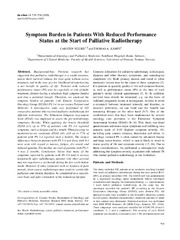| dc.contributor.author | Nieder, Carsten | |
| dc.contributor.author | Kämpe, Thomas A. | |
| dc.date.accessioned | 2021-03-24T09:56:03Z | |
| dc.date.available | 2021-03-24T09:56:03Z | |
| dc.date.issued | 2020-02-28 | |
| dc.description.abstract | <p>Background/Aim: Previous research has suggested that palliative radiotherapy is a useful measure, unless short survival reduces the time spent without active treatment, and in the case of a low likelihood of experiencing a net benefit in quality of life. Patients with reduced performance status (PS) may be especially at risk of futile treatment, despite having a relatively high symptom burden and thus a potential benefit. Therefore, we analyzed the symptom burden of patients with Eastern Cooperative Oncology Group (ECOG) PS 3-4 in our center.
<p>Patients and Methods: A retrospective study was performed of 102 consecutive patients who received palliative radiotherapy for different indications. The Edmonton Symptom Assessment Scale (ESAS) was employed to assess the pre-radiotherapy symptoms.
<p>Results: When applying the lowest threshold (ESAS ≥1), up to 97% of patients with PS 3-4 reported symptoms, such as fatigue and dry mouth. When focusing on moderate/severe symptoms (ESAS ≥4), still up to 77% of patients with PS 3-4 reported such a burden. The largest differences between patients with PS 3-4 and those with 0-1 were seen with regard to nausea, fatigue, dry mouth and reduced appetite. The median survival of patients with PS 3-4 was 2 months.
<p>Conclusion: Given that many of the symptoms reported by patients with PS 3-4 tend to worsen temporarily after radiotherapy, patients with short survival may not experience a net benefit during the few weeks before death. However, if other symptoms such as dyspnea or pain prevail, short-course radiotherapy may result in worthwhile palliation and should, therefore, be considered on a case-by-case basis and after estimation of the remaining lifespan. | en_US |
| dc.identifier.citation | Nieder C, Kämpe TA. Symptom burden in patients with reduced performance status at the start of palliative radiotherapy. In Vivo. 2020;34(2):735-738 | en_US |
| dc.identifier.cristinID | FRIDAID 1812232 | |
| dc.identifier.doi | 10.21873/invivo.11832 | |
| dc.identifier.issn | 0258-851X | |
| dc.identifier.issn | 1791-7549 | |
| dc.identifier.uri | https://hdl.handle.net/10037/20726 | |
| dc.language.iso | eng | en_US |
| dc.publisher | International Institute of Anticancer Research | en_US |
| dc.relation.journal | In Vivo | |
| dc.rights.accessRights | openAccess | en_US |
| dc.rights.holder | Copyright 2020 The Author(s) | en_US |
| dc.subject | VDP::Medical disciplines: 700::Clinical medical disciplines: 750::Oncology: 762 | en_US |
| dc.subject | VDP::Medisinske Fag: 700::Klinisk medisinske fag: 750::Onkologi: 762 | en_US |
| dc.title | Symptom burden in patients with reduced performance status at the start of palliative radiotherapy | en_US |
| dc.type.version | publishedVersion | en_US |
| dc.type | Journal article | en_US |
| dc.type | Tidsskriftartikkel | en_US |
| dc.type | Peer reviewed | en_US |


 English
English norsk
norsk